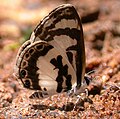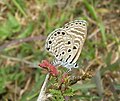| Image | Scientific name | Common name | Distribution |
|---|
 | Azanus isis (Drury, 1773) | white-banded babul blue | Senegal, Guinea-Bissau, Guinea, Sierra Leone, Liberia, Ivory Coast, Ghana, Togo, southern Nigeria, Cameroon, the Republic of the Congo, Angola, the DRC, Uganda, Ethiopia, north-western Tanzania and northern Zambia |
 | Azanus jesous (Guérin-Méneville, 1849) | African babul blue or topaz-spotted blue | Egypt, Syria, India, Sri Lanka and Myanmar |
 | Azanus mirza (Plötz, 1880) | pale babul blue or mirza blue | Afrotropical realm. |
 | Azanus moriqua (Wallengren, 1857) | black-bordered babul blue or thorn-tree blue | Afrotropical realm. |
 | Azanus natalensis (Trimen & Bowker, 1887) | Natal babul blue or Natal spotted blue | Afrotropical realm |
| Azanus sitalces (Mabille, 1899) | large Madagascar babul blue | Madagascar and the Comoros |
| Azanus soalalicus (Karsch, 1900) | small Madagascar babul blue | Madagascar |
 | Azanus ubaldus (Stoll, [1782]) | bright babul blue, desert babul blue, or velvet-spotted blue | India, the Middle East and Africa |
| Azanus uranus Butler, 1886 | Indian babul blue or dull babul blue | India |
| Azanus urios Riley & Godfrey, 1921 | Siam babul blue | India and Thailand |
|






